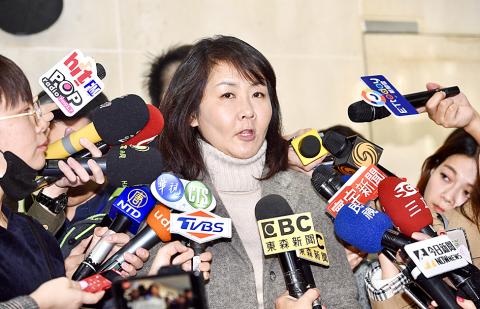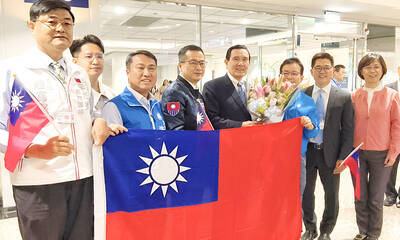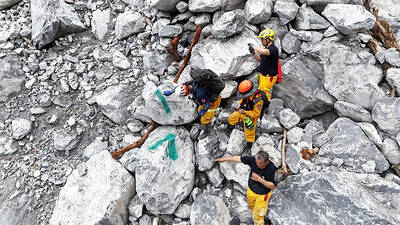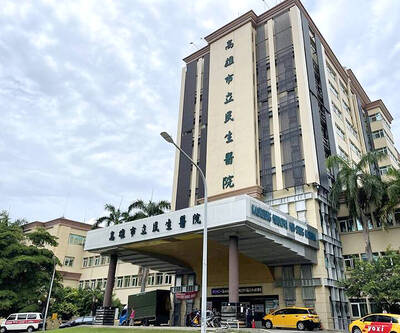The Taoyuan Union of Pilots yesterday offered to hold eight-hour negotiations beginning at 1am today, as it announced plans for a sit-in in front of the Ministry of Transportation and Communications in Taipei in support of striking China Airlines pilots, whose strike enters its sixth day today.
No timeframe was given for the sit-in.
While the ministry and the airline agreed to meet with union representatives, China Airlines said that the union’s proposed start time for the talks was unfair, as it appeared to be an effort to avoid a media presence, even though the negotiations are to be broadcast live over the Internet.

The carrier said that it had agreed to deploy three pilots for flights that exceed eight hours and four pilots for flights that exceed 12 hours, thereby meeting the union’s main terms for resolving the problem of pilot fatigue.
It said that it also agreed to assign three pilots for red-eye flights — those departing between 2am and 5am — if the duration of the flight is more than seven hours.
However, it rejected a new demand by the union that multi-leg flights of more than seven hours should also be assigned three pilots, it added.
The union has defined multi-leg flights as those in which the aircraft makes two or more landings, including round-trip flights between two destinations, while China Airlines said that it defines multi-leg flights as those involving landings at a minimum of three different destinations.
Accepting the union’s demand on multi-leg flights would dramatically raise personnel costs, it said.
Deputy Minister of Transportation and Communications Wang Kwo-tsai (王國材), who took part in three-way negotiations held on Monday night, said that he was extremely disappointed that the union refused to discuss the airline’s proposal for red-eye flights.
The union also did not consider the ministry’s compromise that a third pilot be assigned on a case-by-case basis for flights with a duration of between six and eight hours, he said.
A lack of consensus on this issue led to the strike continuing yesterday for a fifth day.
Union board director Chen Pei-pei (陳蓓蓓) rejected accusations that the union has changed its demands, saying that it has made many concessions, but needs to make additional proposals because of China Airlines’ refusal to amend its working conditions.
The union’s first concession was agreeing to use flight time rather than flight duty period as the basis for dispatching additional pilots, said Chen, one of the first female pilots trained by China Airlines.
The flight duty period refers to the period that commences when a crew member is required to report for duty for a flight or a series of flights and ends when the airplane comes to a full stop at the end of the final flight.
Its second concession was agreeing that the company should dispatch four pilots when a flight’s scheduled duration exceeds 12 hours, instead of 11 hours, she said.
The union had good reasons for demanding a third pilot on multi-leg flights lasting more than seven hours, Chen said.
For example, round-trip service between Taipei and Bangkok totals about seven hours, but pilots actually work eight hours if the waiting time on the ground is included, she said.
Pilots are likely to feel tired in such cases, she added.
While the airline defines red-eye flights as those in which pilots report for duty between 12am and 5am, it can always manage to meet airline regulatory standards by playing semantics, Chen said.
The airline should come up with a better proposal for relieving the fatigue that pilots might experience on multi-leg flights if it thinks that the union’s demand is unfeasible, she said, adding that the union should not keep making concessions while China Airlines does nothing.
The Civil Aeronautics Administration’s Aircraft Flight Operation Regulations (航空器飛航作業管理規則) are the framework that airlines have to follow, but the rules governing the dispatch of pilots must be set through negotiations between workers and management, she said.
The regulations stipulate that the flight time of an airplane begins from the moment it moves away from the gate to take off until the moment it comes to a full stop after landing.
A duty period is defined as beginning when a flight or cabin crew member is required by their airline to report for or to commence a duty and ends when that person is free from all duties.

Former president Ma Ying-jeou’s (馬英九) mention of Taiwan’s official name during a meeting with Chinese President Xi Jinping (習近平) on Wednesday was likely a deliberate political play, academics said. “As I see it, it was intentional,” National Chengchi University Graduate Institute of East Asian Studies professor Wang Hsin-hsien (王信賢) said of Ma’s initial use of the “Republic of China” (ROC) to refer to the wider concept of “the Chinese nation.” Ma quickly corrected himself, and his office later described his use of the two similar-sounding yet politically distinct terms as “purely a gaffe.” Given Ma was reading from a script, the supposed slipup

Former Czech Republic-based Taiwanese researcher Cheng Yu-chin (鄭宇欽) has been sentenced to seven years in prison on espionage-related charges, China’s Ministry of State Security announced yesterday. China said Cheng was a spy for Taiwan who “masqueraded as a professor” and that he was previously an assistant to former Cabinet secretary-general Cho Jung-tai (卓榮泰). President-elect William Lai (賴清德) on Wednesday last week announced Cho would be his premier when Lai is inaugurated next month. Today is China’s “National Security Education Day.” The Chinese ministry yesterday released a video online showing arrests over the past 10 years of people alleged to be

The bodies of two individuals were recovered and three additional bodies were discovered on the Shakadang Trail (砂卡礑) in Taroko National Park, eight days after the devastating earthquake in Hualien County, search-and-rescue personnel said. The rescuers reported that they retrieved the bodies of a man and a girl, suspected to be the father and daughter from the Yu (游) family, 500m from the entrance of the trail on Wednesday. The rescue team added that despite the discovery of the two bodies on Friday last week, they had been unable to retrieve them until Wednesday due to the heavy equipment needed to lift

MIX-UP: Kaohsiung Municipal Min-Sheng Hospital director Yen Chia-chi was suspended from his duties after surgeons operated on the wrong patient last week The Kaohsiung Department of Health yesterday fined Kaohsiung Municipal Min-Sheng Hospital NT$500,0000 for misidentifying two patients and consequently causing one of them to undergo the wrong surgery last week. The hospital’s director Yen Chia-chi (顏家祺) was suspended from his duties. The surgeon who was scheduled to operate on the patient was given a major demerit and is subject to subsequent disciplinary actions. Demerits were given to the anesthesiologist, the nurse in the operation room, the nurse in the ward and the worker who helped transfer the patient from the ward to the operation room for having failed to verify the patient’s identity. Meanwhile, the